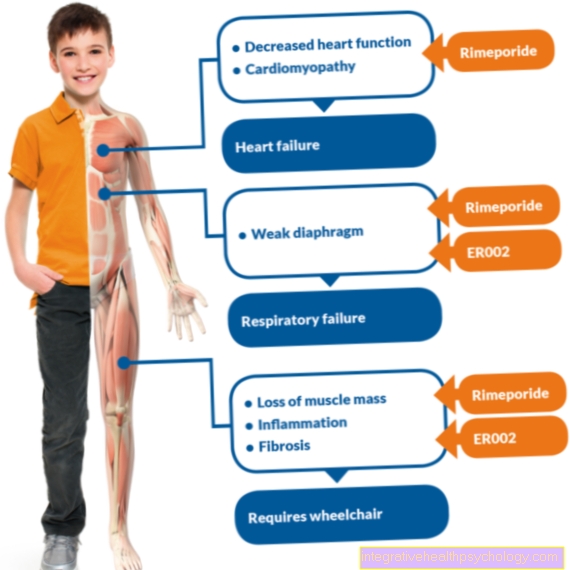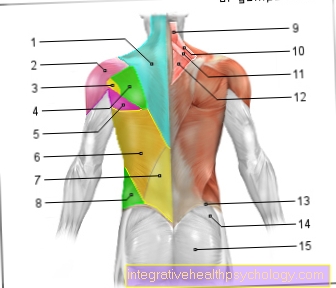Botox®
Synonyms in a broader sense
- Botulinum toxin
- Botulinum toxin
- Botulin
- Botulinum toxin
- BTX
English: botulin toxin, botox
Also read:
- Botox® side effects
- Wrinkle treatment
Definition / introduction
Botulinum toxin (Botox®) is the collective term for seven very similar neurotoxins (neurotoxic proteins), of which botulinum toxin type A is the most common and most important. All these proteins are excreted by various bacterial strains, in particular Clostridium botulinum, which can be found practically everywhere in the soil, but also by a few other species.
The poisonous effect of Botox® comes about because the signal transmission from nerve cells is inhibited. In the past it was feared mainly due to the associated food poisoning, nowadays it is mainly known for its use in medical and cosmetic fields.
Botox® in the narrower sense is the trade name of the drug from the pharmaceutical company Allergan, which contains the active ingredient botulinum toxin type A.
history
1817 described the German doctor and poet Justinus Kerner First time food poisoning, which is particularly common in association with sausage or Canned sausages occurred. After the Latin word for sausage ("Botulus") this poisoning was known as botulism, the poison consequently as Botox® and the bacterium, which was isolated for the first time at the end of the 19th century, as Clostridium botulinum.
Many years later it was discovered that the muscle-paralyzing effect of the poison could be used in medicine. 1980 found Botox® through the Ophthalmologist A. Scott for the first time its use as a medicinal substance to treat people with Squint and eyelid cramp. Even then, Scott recognized the wrinkle-smoothing effect of the poison. 1992 then followed by the Dermatologist A. Carruthers from Canada the first treatment of the so-called frown lines (Glabellar fold = the crease that is created between the eyes when the eyebrows are drawn together). Since then, botulinum toxin A has been used to smooth out wrinkles was used, but the official approval of preparations with this active ingredient for this indication only followed a year later 2002.
Mode of action
Each Muscle fiber is connected to the end of a nerve fiber. To make it contract (to contraction) of Muscle can come, must nerve to release a messenger substance after being excited, which Acetylcholine is called. This transmission of excitation is disturbed by botulinum toxin (Botox®), whereby, depending on the dosage, the muscle contraction is either weakened or no longer takes place at all.
When the poison Botulinum toxin (Botox®) enters the body, it is absorbed by the nerve endings. There it breaks down various proteins, which lose their functions as a result. Since these are usually used for the distribution of Acetylcholine is responsible, this remains under the influence of the poison. The control of the muscle fiber is therefore no longer possible.
Other functions of the nerve, such as this Feel, are not affected by the poison.
Food poisoning from botulinum toxin
In Germany there are around 20 to 40 cases a year Botulinum toxin poisoning (Botox®) that one or two patients do not survive. The first signs of poisoning appear afterwards 12 to 40 hours and mostly concern the first Eye muscleswhy the patient Double vision sees. Then come later Swallowing and speaking disorders, a headache and nausea on. In this condition the poisoning can still be caused by a Antitoxin that aims to remove the poison from the digestive tract. Should the treatment fail or be done too late, it comes from the Paralysis of the heart and Respiratory muscles through to death Cardiac arrest or Suffocation.
That which caused the poisoning Clostridium botulinum bacterium In order to survive and to form its toxin, it needs an environment without oxygen, which is weakly acidic or neutral and offers a wide range of nutrients. Are therefore particularly at risk Canned meat or fishThe formation of the toxin can be avoided by curing the meat, as the nitrite contained in it inhibits the growth of the bacterium.
Before consuming canned food, you should therefore pay attention to whether there are any signs that they are poisoned. For example, an outwardly curved lid of a can or gases escaping when opening, which usually smell bad. If you are not sure whether any of these signs apply, you can protect yourself by boiling the contents of the canned food for a few minutes as the protein Botulinum toxin (Botox®) becomes ineffective.
Medical applications

In neurology, the active ingredient botulinum toxin (Botox®) is used in diseases that lead to increased muscle activity in patients. It has the ability to relieve cramping of the eyelids (Blepharospasm), unilateral spasms of the facial muscles (hemifacial spasm) and tension in the neck area (Torticollis; Spasmodic torticollis; cervical dystonia) to solve. It is also used for muscle tension caused by the brain (focal dystonia). These include, for example, spastic paralysis or tetraspasticity in children (a disease that is often associated with a spastic equinus foot position) or the spasticity of the hands and / or wrists that can occur after a stroke.
In addition, Botox® can be used to inhibit excessive perspiration (Hyperhidrosis), but only if it is very pronounced and has a significant impact on the patient's everyday life and cannot be brought under control through local treatment.
Other areas of application are the treatment of strabismus, tension headaches and migraines, increased saliva production and esophageal obstruction.
In general, muscle paralysis occurs about two to three days after the injection and peaks in about five to six weeks. In order to regain an intact function of the muscle, the nerve end must grow back, which takes about 12 weeks on average; The nerve toxin therefore continues to have an effect over this period of time. When injecting under the skin (in the treatment against increased sweating), however, the effect can last for over a year.
Cosmetic effects
Really became known Botox® but probably only through the application in the Cosmetics as wrinkle smoothers. The targeted paralysis of nerves in the face is used to smooth existing wrinkles or to prevent new wrinkles from forming. It is particularly often used to treat the so-called Frown lines or Crow's feet to disappear from the eyes. It is said to have a rejuvenating effect and provide a more natural result than plastic surgery such as a Facelift, as the facial expressions remain largely unrestricted. The treatment is often carried out in combination with Hyaluronic acid, which occurs naturally in human connective tissue and is injected to fill up the wrinkle from the inside, so to speak.
Treatment needs about all four to six months be repeated to maintain effect and usually cost between 150 and 300 €.





























